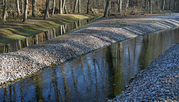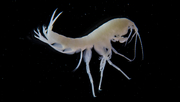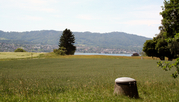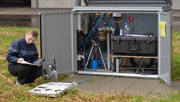Info Day Magazine 2025: Groundwater – utilising and protecting the resource drinking water
80% of Switzerland's drinking water comes from groundwater. Its protection is becoming increasingly difficult, especially in the densely utilised Central Plateau.
New or newly focussed pollutants such as PFAS are raising questions.
Higher water temperatures and longer periods of drought as a result of climate change are exacerbating the situation.
Can suppliers continue to supply consumers with virtually untreated groundwater under these circumstances? Why have problems that have long been recognised, such as nitrate pollution, still not really been solved? Eawag researchers addressed such questions at the Eawag Info Day on 4 September 2025. They presented results and tools that support practitioners and administrators in safeguarding the quality and quantity of drinking water resources. We summarize the most important content in the following articles.
In focus
 | “We must preserve our drinking water resources” |
 | Improving the implementation of legal requirements Legislation requires groundwater protection zones to protect drinking water wells from contamination. However, enforcement deficits and conflicts of use often prevent this. Parliament has therefore passed amendments to the law and other measures to ensure that groundwater can continue to be used as drinking water in the future without the need for extensive treatment. |
 | Less water in summer, more in winter |
 | Specialist in the detection of harmful substances |
 | How artificial intelligence detects nitrate hotspots |
 | Protecting biodiversity underground Groundwater harbours an unprecedented diversity of invertebrate organisms. These feed on microbes, among other things, and help to ensure that the groundwater can be used as drinking water. This biodiversity is reduced in areas with intensive agriculture. Researchers are in favour of systematic monitoring and red lists. |
 | «We want to give groundwater a face» The Swiss Groundwater Network (CH-GNet) promotes the development of knowledge, supports specialised projects and fosters exchange between research and practice. Hydrogeologist Mario Schirmer is a co-founder and member of the network’s management team. Cooperation between science, the authorities and the population is particularly important to him. |
 | Groundwater protection: support inenvorcement The Groundwater Protection Platform supports cantonal agencies, municipalities, water suppliers and consulting offices in the implementation of new groundwater protection tasks in order to ensure a secure supply of safe drinking water in the long term. To this end, it develops new technical principles and practical methods and promotes knowledge exchange. |
 | How groundwater reacts to thermal storage A new type of high-temperature thermal storage system was built to provide a more sustainable supply of heat for the Empa and Eawag site in Dübendorf, which promotes the decarbonisation of the energy system. A research project is investigating how this affects groundwater. |
 | Cities: heat islands underground too The groundwater temperature in cities is often significantly higher than in the countryside. The waste heat from underground buildings in particular causes the temperature to rise, as studies in Basel show. The researchers use 3D heat transport models to calculate the heat input into the groundwater. The heat that accumulates underground could be increasingly utilised for heating. The potential is huge. |
Cover picture: grafikvonfrauschubert, Eawag



